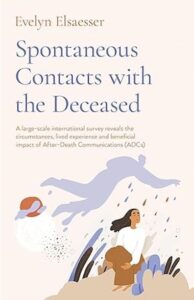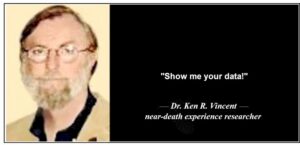1. About the Book, Author, and Reviewer

ABOUT THE AUTHOR: Evelyn Elsaesser (www.evelyn-elsaesser.com) is an independent researcher and author in the field of death-related experiences, notably After-Death Communications (ADCs) and Near-Death Experiences (NDEs). She is the project leader of the long-term international research project “Investigation of the Phenomenology and Impact of Spontaneous After-Death Communications”, as well as a founding and current member of the Board of Swiss IANDS (International Association for Near-Death Studies). She lives in Switzerland. Other books by Evelyn Elsaesser Valarino include: On The Other Side Of Life: Exploring The Phenomenon Of The Near-Death Experience , Lessons from the Light: What We Can Learn from the Near-Death Experience, and Talking with Angel about Illness, Death and Survival: A Novel.
ABOUT THE REVIEWER: Ken R. Vincent holds a Doctorate in Counseling Psychology from the University of Northern Colorado in 1973. He retired from teaching Psychology and the Psychology of Religious Experience at Houston Community College. He is a member of the Alister Hardy Society for the Study of Spiritual Experience and the International Association of Near-Death Studies (IANDS). He is a founding Board Member of the Christian Universalist Association and the former Webmaster of The Universalist Herald website. Dr. Vincent is the author of several books on NDEs, STEs, and Universalism in World Religions including: The Magi: From Zoroaster to the Three Wise Men: a comparison of the religion of the Magi (Zoroastrianism) to Christianity and shows the parallels of Universal Restoration in both faiths; Visions of God from the Near-Death Experience: The wisdom of the prophets and sages of the world’s religions are superimposed upon the accounts of modern-day near-death experiencers to illustrate the similarities between them; The Golden Thread: God’s Promise of Universal Salvation: documents the solid support for Universal Salvation in the Bible as well as research into NDEs and Mystical / Religious / Spiritual Experiences; and God Is With Us: What Near-Death and Other Spiritually Transformative Experiences Teach Us About God and Afterlife – which examines spiritually transformative experiences in light of Universalist principles found in all the major world religions. Dr. Vincent also has an article published on this website entitled Study of Evidential After-Death Communications.
Correspondence regarding this article should be sent to: professorvincent@yahoo.com.
This article was reprinted with permission from De Numine, Vol. 75, Autumn 2023, 24-25, the journal and newsletter of the Alister Hardy Trust.
2. Book Review: Spontaneous Contact with the Deceased by Evelyn Elsaesser
Reviewed by Ken R. Vincent
This book is based on a survey conducted by Evelyn Elsaesser, Chris A. Roe, Callum E. Cooper, and David Lorimer. This book is a major contribution to research on after-death communication (ADC) and also into evidence for life after death.
ADCs are spontaneous and initiated by the deceased, without intention or solicitation on the part of the experiencer. They are direct and without the use of mediums or other devices such as psychomanteums.
Subjects completed a 2- to 3-hour questionnaire consisting of 194 items in either English, French, or Spanish. A total of 1,004 questionnaires were completed. The respondents consisted of 853 women, 144 men, and one “other.” Women responding more to questionnaires is fairly common, but research shows that men experience ADCs as often as women. My own experience is that if men know you are interested and accepting of ADCs or other spiritually transformative experiences, they will tell you about them but won’t write them down. The age range of the sample was 18 to 89 years, with a mean age of 51 years.
A large number of cases are presented in narrative format, and the evidential cases are mixed with the non-evidential cases. It is important to remember that, while “evidential” ADCs are “gold” to researchers seeking evidence of life after death, both types are meaningful and treasured by the experiencer. I know this because I am one of the cases included in the non-evidential ADC group. The study includes subjects who were awake, asleep, falling asleep, and waking.
One type of evidential ADC is that which occurs before the experiencer was notified by conventional means that their loved one was dead (i.e., phone call, e-mail, or personal visit). These accounted for 21% of the cases. These cases are even stronger for evidence of life after death when the death was not anticipated; this was 44% of cases. The study also includes 4 rare cases, including that of 2 shared death-bed visions and 2 shared death experiences.
A majority of the messages from the deceased include: (1) that they are “alive and well” in the afterlife, (2) messages of love and reassurance, (3) encouraging the loved one to come out of their grief, (4) sometimes the prospect of future re-uniting, and (5) sometimes the dead ask for forgiveness.
Returning to evidential information, 24% of experiencers received previously unknown information and 21% also said others perceived the contact. About 12% were frightened by their ADC, but 32% of that group reported that their fright decreased as their ADC progressed. In spite of this, most of the messages were positive. The study included ADCs from strangers (aka, ghosts) in their sample.
Of the deceased who appeared, 53% were men and 33% were women, 4% children, and 9% “other.” Parents, in-laws, and surrogate parents were most often seen, followed by spouses and sweethearts. Before the ADC, 69% of the experiencers believed in afterlife; after their ADC, 93% believed in afterlife.
Skeptics have often dismissed ADCs as self-generated by the experiencers’ grief. Much of the data of this study refutes this. This is especially true of ADCs which happened before the experiencer has been informed by conventional means (such as a phone call) that the person had died. Also, ADCs from a third person in which the experiencer is asked to transmit the information of the ADC to another. We can’t explain this, but it is often speculated that the deceased cannot “get through” to the loved one and contacts someone who is more sensitive.
One of the most important effects of the ADC is its positive effect on the bereavement process. For 36% of the experiencers, the ADC was life-changing; 49% found it important; 9% found it moderately important. ADCs had a significant impact on the experiencers’ religious beliefs and spirituality.
In summary, this is one of the most important books ever written on evidence of life after death in general and ADCs in particular. As an academic who has gone through life asking, “SHOW ME YOUR DATA,” I am ecstatic about this landmark book. Also, as a person who never gets tired of reading individual spiritually transformative experiences, this book is a delight!












